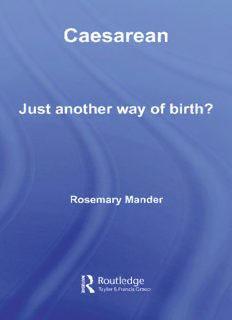
Caesarean: Just Another Way of Birth? PDF
Preview Caesarean: Just Another Way of Birth?
Caesarean About one quarter of births across the UK, Europe and the USA are now by caesarean and the debate provoked by the steadily escalating rates invariably produces more heat than light. The multitude of interested parties – midwives, obstetricians, parents, activists and managers – means that the many different groups talk at cross purposes and without listening to each other. Through this controversial book, Rosemary Mander, a practising midwife and researcher, seeks to find the meaning of caesarean. It critically analyses the place of caesarean in contemporary childbearing and questions the changes that are taking place in childbirth. It explores, in particular, the effects and implications of the increase in caesarean births, and includes discussion of: • the context of the operation and repercussions • caesarean rates around the world and their relation to health systems • decision making and cultural/medical constraints • the short- and long-term implications of caesarean for the woman and her baby. Using a strong research evidence base, Rosemary Mander concludes that the caesarean may not necessarily benefit either the woman or her baby. Rather, it may benefit those professionals whose investment is in extending the range of their influence. Caesareanis accessible to a range of readers and will be of particular interest to the health care provider and the childbearing woman. Rosemary Mander is Professor of Midwifery at the University of Edinburgh, Scotland. She is both a practising midwife and an active midwifery researcher. Caesarean Just another way of birth? Rosemary Mander First published 2007 by Routledge 2Park Square, Milton Park, Abingdon, Oxon OX14 4RN Simultaneously published in the USA and Canada by Routledge 270 Madison Ave, New York, NY 10016 Routledge is an imprint of the Taylor & Francis Group, an informa business This edition published in the Taylor & Francis e-Library,2 007. “To purchase your own copy of this or any of Taylor & Francis or Routledge’s collection of thousands of eBooks please go to www.eBookstore.tandf.co.uk.” ©2007 Rosemary Mander All rights reserved. No part of this book may be reprinted or reproduced or utilised in any form or by any electronic, mechanical, or other means, now known or hereafter invented, including photocopying and recording, or in any information storage or retrieval system, without permission in writing from the publishers. British Library Cataloguing in Publication Data Acatalogue record for this book is available from the British Library Library of Congress Cataloging in Publication Data Acatalog record for this book has been requested ISBN 0-203-96076-9 Master e-book ISBN ISBN10: 0–415–40135–6 (hbk) ISBN10: 0–415–40136–4 (pbk) ISBN10: 0–203–96076–9 (ebk) ISBN13: 978–0–415–40135–7 (hbk) ISBN13: 978–0–415–40136–4 (pbk) ISBN13: 978–0–203–96076–9 (ebk) Contents Acknowledgements ix Introduction 1 1 ‘The game of the name’ 4 1 Beginnings 4 1.1 Terminology 4 1.2 History 6 1.3 Changes in caesarean rates 11 1.4 The significance of caesarean 13 1.5 Conclusion 17 2 What arethe questions and who’s using the answers? Research into caesarean 18 2.1 A‘health warning’ 18 2.2 Randomised Controlled Trials and Evidence-Based Practice 19 2.3 Research ethics and caesarean 21 2.4 The origins of caesarean research 23 2.5 Research topics 26 2.6 Areas yet to be researched 35 2.7 Conclusion 36 3 The caesarean operation – issues and debates 38 3.1 Time factors 38 3.2 Indications for performing a caesarean 42 3.3 Surgery-related issues 46 3.4 Conclusion 56 vi Contents 4 International matters 57 4.1 International background 57 4.2 Comparisons between countries 63 4.3 Discussion – a UK perspective of the international issues 75 4.4 Conclusion 80 5 Caesarean decision making – who’s choosing the choices? 81 5.1 Dynamics of decision making 81 5.2 Clinical, interpersonal and individual decision making 82 5.3 Maternal choice/request/demand for caesarean 99 5.4 Other factors influencing the caesarean decision 104 5.5 Non-consensual caesarean 109 5.6 Higher order decisions 111 5.7 Conclusion 113 6 The immediate implications of caesarean 114 6.1 The implications for the woman 114 6.2 The implications for the baby 126 6.3 Mother and baby 129 6.4 Maternal mortality 130 6.5 Iatrogenesis 131 6.6 Conclusion 134 7 The long-term implications of caesarean 135 7.1 Implications for the woman 136 7.2 Implications for the baby 147 7.3 Implications for others 149 7.4 Consumer groups 153 7.5 Conclusion 154 8 The significance of trial of labour and VBAC (vaginal birth after caesarean) 156 8.1 Words and the woman 156 8.2 Research matters 159 8.3 Health issues 164 8.4 The significance of safety 167 8.5 Conclusion 171 Contents vii 9 Conclusion 173 9.1 The status of caesarean 173 9.2 Long-term developmental views of caesarean 174 9.3 Medicalisation and women 176 9.4 Risk 179 References 180 Index 205 Acknowledgements Iacknowledge the inspiration of the women and the midwives with whom I have had the privilege to practise. I have learned more from them than they will ever realise. Although this book is my responsibility, I would like to thank the following for sharing their thoughts, their ideas and sometimes their work with me: Agency for Healthcare Research and Policy, Alison MacFarlane, Beverley L. Beech, Chryssoula Lemonidou, David Lamb, Debbie Harrison, Deborah Purdue, Ekaterini Kasidi, Elias Mossialos, Geraldine Barrett, Gian Carlo DiRenzo, Gordon Lyons, Graeme D. Smith, Irena A. Frei, Irene Calvert, Jackie Baxter, Jane Weaver, Jenny Newland, Kath Melia, National Childbirth Trust, Ngai Fen Cheung, Norelle Groeschel, RCM Library, Sheila Kitzinger, Sarah Stewart, Sinead McNally, Steve Tilley and Wang Liston. My most profound thanks go to Iain Abbot. His searching questions, while not always welcomed, may have enhanced the material in the book.
Description: